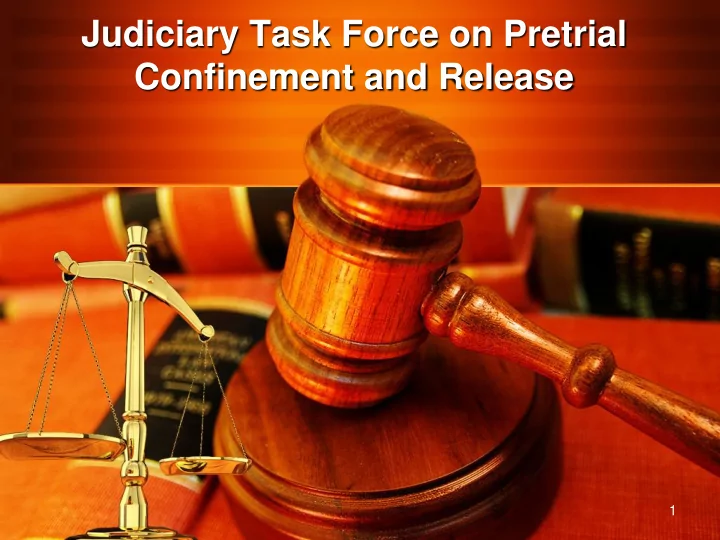

Judiciary Task Force on Pretrial Confinement and Release 1
Introduction Richmond I Right to counsel at initial hearing and bail review. Statutory interpretation; P.D. Statute (CP 16-204) • Legislative compromise, Public Defender at bail review • Created Legislative Task Force Richmond II Article 24, Md. Constitution interpretation. Right to counsel at initial hearing • Judiciary Task Force Fiscal challenges and political realities 2
Current Pretrial Confinement and Release System • All arrested defendants presented for initial appearance within 24 hours of the arrest • Initial appearance before District Court Commissioners; 278 commissioners, working 24/7/365 • In 2012 commissioners conducted nearly 173,000 initial hearings (50% ROR) • At initial hearing commissioner: • Determines probable cause from paper evidence • Informs defendant of each charge • Provides advice of right to an attorney • If felony, advises of Preliminary Hearing • If defendant not released by commissioner, appears for a bail review before a judge 3
Challenges In Present System 1. Two duplicative hearings, often within 12 hours, involving same evidence, to resolve same issue of pretrial confinement or release for at least 80,000 defendants who were not released on ROR 2. Requires police, sheriffs or detention facility officers to transport defendant at all hours, to and from the hearing 3. In some instances, a lengthy queue at commissioner station causes the officer and defendant to wait which can create security issues and precludes officers from attending to other duties 4. Access and space considerations impact ability of public to attend and observe commissioner hearings 5. Access and space considerations impact victim input pertaining to release of defendant 4
Challenges In Present System 6. Structural barriers inhibit private attorney client consultation 7. Lack of equipment for remote access at all locations 8. Current system not equipped to accommodate all necessary interpreter services, i.e. private consultation between attorney, client, and interpreter 9. In addition to all these logistical issues, we now face the fiscal reality of an estimated $28,000,000 to $30,000,000 annually to provide public defender representation 5
Proposed Alternatives L egislative Task Force and others are working on ways to improve the current dual hearing model and the following recommendations have been offered: • Eliminate commissioners (Rejected) • One hearing before judge • Security risk assessment tool to release without a hearing • Create new statewide pretrial release agency • Eliminate or reduce reliance on secured monetary bonds in making release decisions • Preset bond schedule • Night Court/Weekend Court Increased release discretion by law enforcement • • Simply provide funding to OPD and maintain dual-hearing system 6
Judiciary Task Force on Pretrial Confinement and Release Chief Judge Barbera determined a comprehensive approach was needed that considered all alternatives in both an operational and fiscal context, utilizing the internal expertise of the Judiciary. 7
Judiciary Task Force Proposal 1) Eliminate duplicative hearings; one hearing by a judge within 24 hours five days a week: • Accounts for approximately 75% of all current hearings statewide • Administrative Judge may need to employ creative docketing • Cross designations of circuit judges to provide assistance as needed • Conduct more initial hearings by video including having a judge cover several counties within the district 8
Judiciary Task Force Proposal 2) Retain the necessary number of commissioners to: a) Conduct initial hearing on weekends and holidays b) Perform other functions committed to commissioners • Issuance of interim, protective and peace orders • Applications for charges by police and members of the public c) Possibly serve as statewide pretrial release unit to gather and verify necessary information to make recommendations to judges (not to monitor compliance with conditions of release) 9
Judiciary Task Force Proposal 3) Judiciary will continue to study the viability and usefulness of variety of techniques under discussion to reduce the number of defendants needing pretrial detention or to make system more effective: • Determine whether a reliable FTA/security risk assessment matrix can be developed that may allow administrative release decisions prior to a hearing or allow for a more informative hearing • Examine the feasibility, from both an operational and cost perspective, of having judges conduct initial appearances on weekends by video conference 10
Judiciary Task Force Proposal 4) Judiciary will continue to participate in efforts to reduce pretrial population: • Expand the use of citation or summons in lieu of an arrest • Consider the conversion of minor victimless offenses to civil infractions 11
Implementation and Cost Considerations 1) Single presentment of all arrested defendants before a District Court judge 5 days per week; 12 judgeships ($3,601,000) (Cost includes Judgeship, Clerk, Bailiff and subsidies) 2) Additional costs attendant to facility and space requirements: • Expanded use of video conferencing and multi-county hearings ($1,900,000) • Space for new judgeships ($514,000) • Local justice partners operational requirements (Cost ?) 12
Benefits • Eliminate cost and expense of duplicative hearings • Reduce OPD budget increase of $28 to $30 million • Improve issues related to transportation, security, and other logistical concerns • Improve transparency and public confidence • Victim participation • Create pretrial system for judges utilizing existing workforce while maintaining ability to perform other duties by the commissioner • Flexibility of a judge conducting the hearing • May reduce need for all/some Preliminary Hearings • Reduce pretrial incarcerations and pretrial confinement for less serious offenses 13
QUESTIONS? 14
Recommend
More recommend